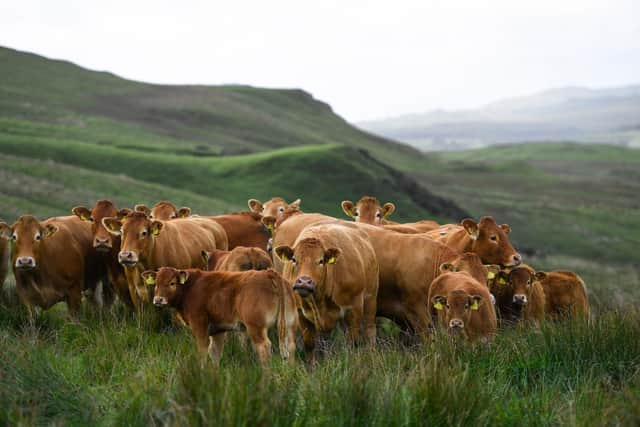Limousin leader highlights opportunity for reduction in retail emissions from beef by focusing on genetics and genomics
and live on Freeview channel 276
With 36,000 animals genotyped, the British Limousin society has the biggest data set of genotypes compared to any other UK beef breed.
The decision to share this insight comes as analysis highlights significant differences in the emissions potential from beef breeds, with Limousin cattle producing up to 30 per cent fewer methane emissions in the finishing period.
Advertisement
Advertisement
A range of benefits play into this reduction, but all can be linked to the presence of the F94L myostatin gene which is found naturally in the Limousin breed and which the British Limousin Society has now termed the ‘Green Gene’.


Early data analysis from the society’s genomic data set is drawing significant trend patterns which are suggesting that it is the efficiency delivered by the Green Genes which can reduce emissions. Whilst further analysis is needed, it clearly demonstrates the need for the beef sector to be gaining a better understanding of genetics to deliver more beef from less input.
The findings are also supported by preliminary data from AHDB’s National Beef Evaluation which shows that of calves sired by bulls born in the last 10 years:
- The calves sired by pedigree Limousin bulls finished on average 29 days earlier than the average of all calves by the main continental sire breeds (Simmental, Charolais, British Blue, British Blonde and Salers).
Advertisement
Advertisement
- If finishing costs of £3/day are assumed (will vary), Limousin progeny are worth ~£87/head more owing to early slaughter.


- This difference equates to a reduction of over 4.3kg CO2 equivalents of greenhouses gases per finished animal (29 *151g).
- The calves sired by pedigree Limousin bulls finished on average 17 days earlier than the average of all calves sired by the main native breeds (Aberdeen Angus, Hereford, Stabiliser, Beef Shorthorn and South Devon).
- This difference equates to a reduction of over 2.5kg CO2 equivalents of greenhouses gases per finished animal (17*151g).
Advertisement
Advertisement
Alice Swift, CEO of the British Limousin Society, said: “The more we understand the data, the more significant an opportunity this could be for retailers targeting net zero. This data provides clear evidence for the efficiency beliefs around Limousin cattle that many farmers have claimed for decades. It means that retailers looking to reduce emissions across their core beef ranges can do so in the most efficient way possible to help ensure the beef sector remains profitable for farmers and affordable to consumers.”
When considering efficiency in the sector, the clearest outcome that illustrates this inefficiency is in animals sired by natives or continentals in the dairy beef sector. Of calves born since 2013, AHDB’s beef evaluation set shows only 15 per cent of native breeds deliver an R grade or better in the EUROP Grid, meaning no pence per kilo deductions, whilst continental breeds deliver at 66 per cent.
It’s this data that Alice says should make the government consider continental breeds when developing incentives, payments, and schemes for the sector.
She continued: “Bringing this type of data analysis into the beef industry is essential if we are to make the right long-term decisions. Recently there has been much discussion over supporting native breeds and incentives to graze, but to what end?
Advertisement
Advertisement
“A fair playing field for all British beef breeds, including those with continental heritages, would provide greater space for breeding and purchasing decisions to be based on reducing emissions and driving efficiency across the sector.”
In considering how the sector gets back on track with efficiency and emissions, Alice Swift believes four key areas should be a priority for 2024:
- Genomics: Genetics data can tell us so much about our animals. From health to growth patterns and breeding benefits. Every farmer and all those who buy beef will have differing priorities, but lower emissions must unite us all. You only have to look at the dairy sector to see how a better understanding of genetics can have a profound impact on the development of an industry. Next year, it’s the turn of Beef! We need the Government and retailers to prioritise and support the sector in further understanding the data that can deliver long term sustainable benefit and greater efficiency.
- Consumer understanding: The data shows that Limousin is the most sustainable beef in terms of emissions (up to 30% fewer daily methane emissions). There is a place for promoting different breeds in different ways and much has been invested to gain consumer awareness of some native breeds. However, when considering the bulk of UK purchases at mid or value tiers, Limousin presents a is significant opportunity.
Advertisement
Advertisement
- Age to slaughter: we must look at this alongside carcass conformation. Chasing lower ages to slaughter for the purpose of emissions recording is negated if those cattle have poor carcass conformation and a lower kill out percentage, essentially creating less from more.
- Feed intake: The difference between high and low intake animals is real – some animals are consuming almost double the dry matter intake to achieve the same level of performance. The Government has made a good start in investing in feed efficiency projects, however, It is only with better genotyping and sector data that we will be able to breed more sustainable animals.